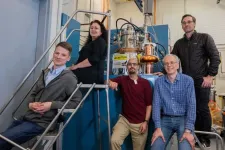(Press-News.org) URBANA, Ill. – Early childhood is an important time for learning about nutrition and establishing healthy eating behaviors. Young children rely on parents to provide food options, and the availability of food in the home affects their dietary choices. A new study from the University of Illinois Urbana-Champaign looks at changes in home food availability and nutrient intake for children from 2 to 4 years old.
“It's important to understand how the environments that children are in can influence their diet and nutrition. What types of foods and beverages are available in the home, and how accessible are those items for the young child? It’s about the likelihood of exposure to foods and having the opportunity to try foods, and also whether they may be able to access or grab foods themselves,” said lead author Jennifer Barton, now an assistant research professor at Pennsylvania State University. Barton conducted the research as a postdoctoral research associate at the Family Resiliency Center in the Department of Human Development and Family Studies (HDFS), part of the College of Agricultural, Consumer and Environmental Sciences (ACES) at Illinois.
Barton and her colleagues used the Home Food Inventory (HFI) to measure food availability at 24, 36, and 48 months of age. The HFI is a comprehensive checklist of food categories administered by a research assistant visiting the homes of participating families. The researchers correlated the HFI data with surveys of the children’s food consumption completed by their mothers.
“We found significant changes in several food categories over time. Food items such as non-whole grains, processed meats, savory snacks, candy, and microwavable or quick-cook foods were more commonly available in the home at 48 months compared to 24 and 36 months,” Barton said.
The study included 468 mothers and children who were participants in STRONG Kids 2, an ongoing research project at Illinois that looks at nutrition and healthy habits from infancy through 10 years of age. STRONG Kids 2 co-directors Barbara Fiese, professor emerita of HDFS, and Sharon Donovan, professor of food science and human nutrition at Illinois, also contributed to the study.
The HFI includes an obesogenic score, which indicates the obesity risk of different foods. However, the scores are based on dietary recommendations for older children and include regular-fat dairy products such as milk, yogurt, and cheese. Toddlers have different energy and nutrient needs, and dairy products are considered as part of a healthy diet for young children, necessary for growth and development.
The researchers tested three obesogenic scores, two of which were developmentally sensitive scores that excluded milk, yogurt, and cheese. Even with the modified categories, they found that obesogenic scores increased significantly from 24 to 48 months.
“It makes sense that as children get older, the presence of more energy-dense and high-fat foods tends to grow. Children may request these foods more often, and outside influences, such as the opinions of peers, are starting to become more apparent. I do want to point out that we found some positive changes. Vegetables also become more available in the home at 48 months,” Barton said.
“The point is not to label certain foods as being good or bad. We likely all have food items in our home that are not ‘recommended.’ It’s really about trying to make sure that we get enough nutritious, recommended foods and eat the non-recommended items in moderation.”
A second research goal was to test the validity of the HFI measure for young children, as the method has been developed for adolescents. Barton and her colleagues conducted comprehensive tests of associations between food availability and nutrient intake, overall finding the expected results.
For example, the availability of processed meats such as lunch meat and hot dogs was correlated with higher saturated fat intake. Sweetened beverages, candy, desserts, and savory snacks were correlated with higher intake of those foods. A higher presence of fruit and vegetables in the home was also a consistent indicator of nutrients. These findings indicate that HFI is a reliable measure of home food availability and has demonstrated associations with food and nutrient intake for children ages 24, 36, and 48 months, the researchers conclude.
It’s important to support parents in making healthy decisions for their families, but food choice is much more than individual behavior, Barton stated.
“There are complex factors affecting parents’ decisions. Children may ask for certain foods, which may stem from the influence of media and advertising. We should also consider who else lives in the home such as siblings, and the parents may experience work demands and financial stressors that can spill over into their family life. Many people struggle with distance to food stores and access to fresh foods as well as food insecurity. I believe we need a food systems approach to ensure people have access to nutritious food and that parents feel supported in making decisions to promote the health and well-being of themselves and their children,” she concluded.
The paper, “Longitudinal Changes in Home Food Availability and Concurrent Associations with Food and Nutrient Intake Among Children at 24 to 48 Months” is published in Public Health Nutrition [DOI: 10.1017/S1368980024000375]. Authors include Jennifer M. Barton, Arden L. McMath, Stewart P. Montgomery, Sharon M. Donovan. and Barbara H. Fiese.
This research was funded by grants from the National Dairy Council, the Gerber Foundation, the Christopher Family Foundation, Hatch ILLU 793–330 from the US Department of Agriculture, and the National Institute of Diabetes and Digestive and Kidney Diseases (NIDDK), National Institutes of Health (grant no. R01 DK107561) to Sharon Donovan. The content is solely the responsibility of the authors and does not necessarily represent the official views of the National Institutes of Health.
END
Study: How home food availability affects young children’s nutrient intake
2024-03-14
ELSE PRESS RELEASES FROM THIS DATE:
A pioneering way to target the culprit behind a deadly liver cancer
2024-03-14
Cell division is the generative spark of nearly every lifeform on Earth. But if healthy growth goes unchecked, cell division can turn lethal, overwhelming the organism. Such is the case with so-called oncogenes. When altered by a mutation, these growth-moderating genes go haywire, producing a geyser of cancer cells as a result. Oncogenes are also insidiously adept at generating tumors that over time become genetically “independent” from their origin, so it has been exceedingly difficult for scientists to shut down their replication ...
Clay Wright receives MIRA funding to create new molecular tools
2024-03-14
Clay Wright, assistant professor in the College of Agriculture and Life Sciences’ Department of Biological Systems Engineering, was awarded a prestigious Maximizing Investigators' Research Award (MIRA) from the National Institute of General Medical Sciences, part of the National Institutes of Health.
The funding is aimed at providing the investigator, versus a specific project, enhanced stability and flexibility for further discovery, enhancing scientific productivity and the chances for significant breakthroughs outside the initial scope of the project.
This recognition supports Wright's innovative work in understanding ...
Shade-grown coffee demonstrates the benefits of combining agriculture and conservation, an Oxford Brookes University study reveals
2024-03-14
Increasing shade cover over coffee plants can increase biodiversity and provide new ways to combine agriculture and conservation, a new study has revealed.
Coffee grown in high shade, with more than 30% canopy cover, provides a home to more plant and animal species than coffee grown in the sun or on low shade farms with less than 30% canopy cover, the study found.
Preserving biodiversity is good news for farmers as it means better natural pest control, and improved soil ...
Mind the mask!
2024-03-14
Building on what was learnt to one's cost during the pandemic to improve health management in the future. This motivation has led scholars and researchers to take up the topic and investigate various aspects beyond the emergency phase.
Just recently, an article by the first signatory and corresponding author, Giuseppe Alessandro Veltri of the Department of Sociology and Social Research of the University of Trento, focused on the public health guidelines adopted during the pandemic. The research team assessed the effect perceived ...
Dr. Lawrence J. Rosenblum elected IEEE Fellow
2024-03-14
WASHINGTON – U.S. Naval Research Laboratory (NRL) researcher, Lawrence Rosenblum, Ph.D., was elevated to the prestigious grade of Fellow of The Institute of Electrical and Electronics Engineers (IEEE) in the class of 2024 for leadership in developing mobile augmented reality, visualization and visual analytics of complex data. Fellow is IEEE’s highest member grade and is awarded through a rigorous review process only to candidates with extraordinary accomplishments.
Rosenblum joined NRL’s Acoustics Division ...
New study on mating behaviors offers clues into the evolution of attraction
2024-03-14
Sparks fly when a female nematode meets her mate in a Petri dish. Tracking him by smell, she beelines over and is pregnant within moments of physical contact. But for the hermaphroditic version of these tiny roundworms, it’s a very different story. Anatomically female but capable of self-fertilizing with their own supply of sperm, hermaphrodites remain emphatically uninterested in mating—until their sperm supply runs dry. Only then will they seek out males.
Within such previously unknown details about microscopic mating rituals ...
Adapting particle accelerators for industrial work
2024-03-14
NEWPORT NEWS, VA – Superconducting radiofrequency (SRF) technology allows particle accelerators to efficiently produce powerful electron beams. Physicists use these beams to study the building blocks of matter at the U.S. Department of Energy’s Thomas Jefferson National Accelerator Facility. But these research machines also have a promising list of industrial applications. Now, some researchers are figuring out how to get SRF accelerators out of the lab and into industry.
One potential industrial use is in water treatment plants.
Per- and polyfluoroalkyl substances (PFAS) are present in many products, including certain non-stick cookware, water-resistant ...
One in five state Medicaid programs covers weight loss medications
2024-03-14
Mounting evidence suggests that FDA-approved weight loss medications, such as Wegovy, not only help patients lose weight but also protect against complications from obesity such as cardiovascular disease. In 2021, 40 percent of patients enrolled in Medicaid had obesity. The high cost of these drugs has raised concerns about affordability, both for patients and public insurance programs.
Researchers from Brigham and Women’s Hospital, a founding member of Mass General Brigham, studied state Medicaid coverage policies for anti-obesity medications from 2011 through the first quarter of 2023, finding that 10 out of 47 states covered at least ...
Aston University to shrink carbon footprint of industrial gas burners
2024-03-14
Aston University is working with an engineering company to make industrial gas burners less environmentally damaging
It has entered a knowledge transfer partnership (KTP) with Lanemark Combustion Engineering
A KTP is a three-way collaboration between a business, an academic partner and a highly qualified researcher.
Aston University is working with an engineering company to make industrial gas burners less environmentally damaging.
The University has entered a knowledge transfer partnership (KTP) with Lanemark Combustion Engineering to ...
Initial SARS-CoV-2 vaccinations prime immune cells to respond to subsequent variants
2024-03-14
PHILADELPHIA – Antibody responses to new SARS-CoV-2 variant infections and vaccinations are powerfully shaped by prior exposures to earlier SARS-CoV-2 vaccines, according to a new study from the Perelman School of Medicine at the University of Pennsylvania.
In the study, published today in Immunity, the researchers analyzed antibody responses in people infected with or vaccinated against the relatively new SARS-CoV-2 variants BA.5 and XBB. They found that even though BA.5 and XBB are very different from the original “ancestral” ...




